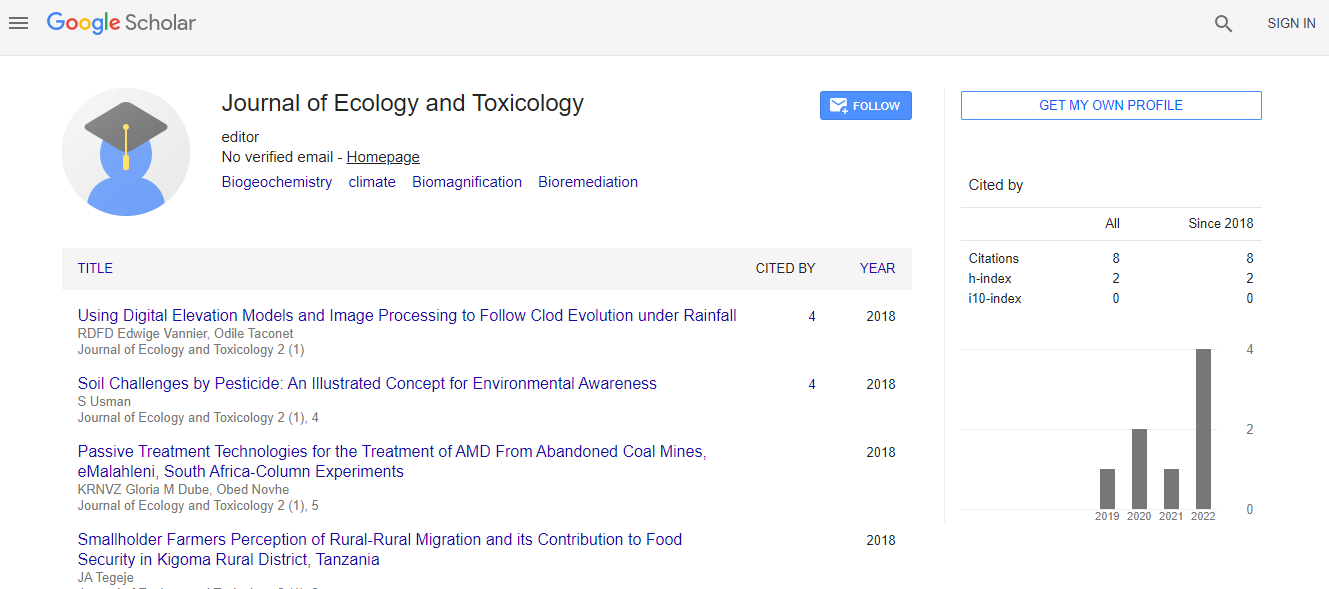Research Article
Trace Metal Speciation and Pollution Risk Assessment of Sediments from Etim Ekpo River, South South, Nigeria
Moses EA*, Udiong D and Udosen EDDepartment of Chemistry, University of Uyo, Uyo, Nigeria
- *Corresponding Author:
- Eno A. Moses
Room 152, Faculty of Science Building, University of Uyo Main Campus
Nwaniba Road, Uyo, Akwa Ibom State, Nigeria
Tel: +234 814 612 9875
E-mail: enomoses27@yahoo.com
Received date: April 24, 2017; Accepted date: May 18 30, 2017; Published date: May 20, 2017
Citation: Moses EA, Udiong D, Udosen ED (2017) Trace Metal Speciation and Pollution Risk Assessment of Sediments from Etim Ekpo River, South South, Nigeria. J Ecol Toxicol 1:103.
Copyright: © 2017 Moses EA, et al. This is an open-access article distributed under the terms of the Creative Commons Attribution License, which permits unrestricted use, distribution, and reproduction in any medium, provided the original author and source are credited.
Abstract
This study was aimed at the determination of the levels of some metals (Pb, Cd, Zn, Cu, Cr, in sediment from Qua Iboe River at Etim Ekpo, Akwa Ibom State, Nigeria, The river sediments were sampled from five different stations along the river for a period of eight months covering wet and dry seasons. These were analysed for trace metals using atomic absorption spectrophotometry. The different species of the metals in sediments were further quantified using PHREEQC geochemical model developed by United States Environmental Protection Agency (USEPA) and five step sequential extraction procedures respectively. The concentrations of metals in mg/kg during the wet season were: Pb (5.99-7.15), Cd (0.02-0.03), Zn (10.02-18.83), Cu (7.43-10.66) Cr (0.05-0.14). The ranges in the dry season were: Pb (3.03-6.77), Cd (0.015-0.022), Zn (9.20-13.77), Cu (7.04-8.50) Cr (0.008-0.150). The levels of trace metals under study all fell below the sediment quality guidelines. The PHREEQC geochemical model revealed that the major and trace metals exist predominantly as free ions with maximum molal concentrations and percentage distribution in the wet season as follows: (Cu2+: 2.45E-05, 94.19%, Cu+, 7.706E-07, 2.58%, Pb2+:3.99E-05, 79.84%, and Cr3+, 4.49E-08, 0.11%, Zn2+ 3.52E-04, 97.83%) while the values in the dry season were: (Cu2+: 1.77E-07, 98.05%, Cu+, 8.27E-09, 96.29%, Pb2+: 9.42E-09, 97.66%, and Cr3+, 1.65E-10, 1.92%%, Zn2+ 1.01E-06, 99.90%). The trace metal species present in the sediment were predominantly of the residual fraction while the bioavailable fraction constituted a medium risk to aquatic environment. The speciation percentages from the sequential extraction procedure revealed that the exchangeable and the bound to carbonates fractions of the sediment samples were of the medium risk category at all sampling stations in both seasons except in dry season at Uruk Ata Ikot Isemin where Pb, Cd, Zn and Cr were within the low risk category. The sediment quality seems safe at present levels. However, proper administrative and legislative measures should be applied to protect the river source.

